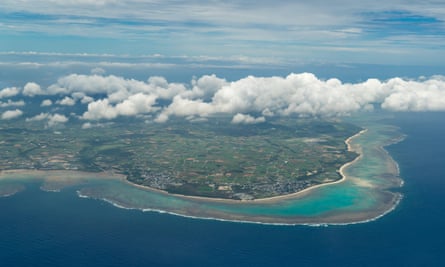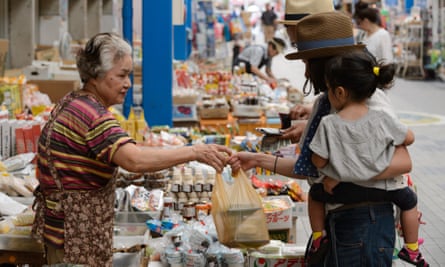The Chinese flotilla arrived at the start of August, more than 300 fishing boats escorted by 15 vast coastguard ships, some of them armed. They circled the Senkaku Islands for a week, drifting into and out of Japanese territorial waters as Tokyo’s own coastguard played cat and mouse with the intruders.
Then they were gone, but the message they left behind was clear. China had upped the stakes again in a simmering territorial dispute that has made the southern tip of Japan’s island archipelago one of the most dangerous places in the region.
Ishigaki Island does not look like a frontline. Japan’s own tropical idyll, it is a sleepy place of pineapple fields and mango orchards, where thousands of tourists potter along white sand beaches and scuba dive in crystal clear seas. Yet this tiny dot on the edge of the Pacific is the closest Japanese town to the uninhabited but fiercely disputed Senkaku Islands, once inhospitable home to a tuna processing factory, now abandoned but key to lucrative fishing grounds, oil and gas fields and a strategic shipping route.
Under other circumstances the rocky outcrops – their name means sharp pavilions – would have only a unique species of mole as their sole claim for international attention. But their location, and competing claims of ownership from China, Japan and Taiwan have made them a potential flashpoint for war and focus of extreme anxiety from Tokyo to Washington.
Beijing’s maritime ambitions have been thrown into sharp focus by its extraordinary creation of a chain of islands from previously open seas over the past few years. It has shored up ambitious claims to swaths of ocean far from the Chinese coastline with the frantic construction of artificial islands that has seen runways, radar and guns appear on what were submerged coral reefs just five years ago.

Its strategic plans for the East China Sea have drawn less attention, perhaps because developments have not been so dramatic. But the prospect of tensions escalating into hostilities is real.
It faces in Japan a more powerful rival than any farther south, and one that has the US as a protector, bound by treaty to come to Tokyo’s aid if its territory is attacked. Relations between the uneasy neighbours are so strained that they have not even got a hotline set up for military communication in a crisis, despite years of talks aimed at establishing one.
The issue is so pressing that when new US defence secretary James Mattis visited Tokyo last week, confirming America’s commitment to defend the islands was top of the foreign minister’s agenda.
“Secretary Mattis made clear that the Senkaku Islands are in the territories under the administration of Japan,” Fumio Kishida said after the meeting. China promptly responded with a warning that the American politician’s “wrong remarks” put Asia’s stability at risk.
Few tourists visiting Ishigaki notice the trouble that is brewing in paradise, but those who live on the island have seen a slow escalation in tensions transform their town and lives, particularly those of the fishermen chased away from the Senkakus by Chinese boats.
“What is frightening for us is that when we go there, the Chinese government ships aggressively approach us, they are much larger than our fishing boats and we are afraid of collisions,” said Manabu Namisato, 53, who has been fishing for three decades.
Four years ago a Chinese coastguard ship around 150 times the size of his 10-tonne tuna fishing vessel nearly rammed him on the high seas. “I don’t know if they are coming towards us intentionally or not,” he said, but the memory still unnerves him. “If that boat had hit me I wouldn’t be here today.”
The fishermen have been warned for their own safety to stay away, but don’t need to be told. “It’s not that we don’t want to go there, it’s that we can’t go there. We have agreed to talk to you, because we are afraid the situation may get worse.”
The fleet that arrived last August was exceptionally large, but comes after years of regular incursions – and the government fears another influx this summer.
From Ishigaki to Tokyo, many Japanese fear that the aggressive coastguards and the fleets they shepherd to the Senkakus are part of a plan from Beijing to bolster China’s claim to the islands by establishing de facto control of the area’s fishing ground.

“There is possibility the Chinese government will use this fact that our fishing boats are not going there,” admitted an official from the ministry of foreign affairs, adding that the argument would have little standing under international law.
Still, rising numbers of Chinese boats flooding into the area each year have put Japan in a difficult position. It does not want to look weak but fears using military force would give China a long-awaited excuse for further confrontation.
“If we send ships in the Chinese government will use this to further escalate the situation and we don’t want that,” the official added.
Both sides claim history is on their side, although Japan is the only country ever known to have citizens living on the islands – for two decades last century. China’s claim is also slightly undermined by its timing, with the first objection to Japanese ownership claims lodged only after publication of a UN report locating deposits of oil and gas nearby.
There has already been a sharp rise in tensions since 2012 when Japan nationalised the islands. The move warded off a planned sale to Tokyo’s then mayor, a hardline nationalist apparently hoping to develop the islands, which would certainly have inflamed sentiments in China.
But Beijing saw, or chose to see, aggression where Tokyo felt it was defending an uneasy status quo. Soon violent protests broke out around China, with Japanese cars, shops and factories vandalised, several firms shutting down production and tour trips abruptly cancelled.
At sea, everything changed. Chinese coastguard ships now regularly sail towards the islands, often escorting fleets of fishing boats. And where once the Chinese boats would stray into Japanese waters perhaps once every couple of years, there has been such a regular pattern of two or three monthly violations in recent years that it is hard not to see a schedule.
Japan says China now has a fleet that includes repurposed naval ships, the largest coastguard patrol in the world, and arms on many vessels. In response Japan has expanded its own coastguard, taking the Ishigaki fleet alone to 16 boats stationed at a newly extended pier.
There are daily patrols to the Senkakus, a trip of five or six hours each way, with teams on standby to show up in greater force. “Right now our current policy is to exceed the Chinese vessels around Senkaku, so if they are showing up with three or four, we want more, if they show up with six or seven we want more,” said Hiraki Odagi, spokesman for the Japanese coastguard.
The boats have cannons, and some of the sailors bear arms, but their missions are shrouded in military secrecy. “I’m only at liberty to say we had more than the number of Chinese vessels,” Odagi said.
China’s air force is also testing Japan’s defences, with Japanese fighter jets now scrambled twice a day on average to warn incoming aircraft away from the air space over the islands. There were 22 scrambles in 2008, but 644 last year.
Some in Ishigaki, alarmed by China’s encroachment on the islands, feel Japan should have done more to assert its control over the islands decades ago, when China had less money, less military power and less international clout.
“I now think that the Japanese government should have done something,” said Yoshitaka Nakayama, mayor of Ishigaki, who is calling on the government to push ahead with plans to deploy a unit of the Japanese military, formally known as the self-defence force, to the island. “Meanwhile China has become a superpower… and if we continue to put this issue on the shelf and not do anything then China will become even more powerful.”
Even a small harbour, or pier, on the main Senkaku island where fishermen could take shelter in bad weather might persuade more to risk a trip to the area, while reinforcing Japanese claims, he says. But years of pleas have fallen on deaf official ears, and Nakayama fears Tokyo’s caution could pave the way for disaster.
“The situation I am worried about is this – a Chinese ship or fishing boat would come to the island, and fishermen land on the island. Then Japanese police and coastguard officials would go on the island to remove them. Then the Chinese will give a reason to deploy warships to the island, saying ‘we need to protect our citizens’.”
The dispute goes to the heart of concerns about China’s growing ambition, as it looks to project power across a region once dominated by America. And while its expansion in the South China Sea has caused alarm around the world, Japanese officials point out that East China Sea, where the Senkakus lie, is even closer to China’s shoreline and on the path out to the Pacific.
In Ishigaki many believe a stronger position is the only way to ward off disaster, with a bullishness that carries a disturbing echo of China’s own uncompromising stance.
“I think the Japanese government has prioritised the relationship with China, including economic ties,” said Yoshiyuki Toita, secretary general of the Yaeyama Defence Association which brings together more than 100 people on Ishigaki and its surrounding islands to campaign and study.
“If we just worry about temporary economic loss and give in, China may create a military facility in this area, so there will be more national security loss than economic loss. Japanese people should understand that and we should raise awareness about issues of territorial claims.”
Disputed territories
1 DMZ (demilitarised zone between North and South Korea)
Pyongyang’s nuclear ambitions keep tensions high in a heavily militarised peninsula
2 Kuril islands held by Russia, claimed by Japan as part of its ‘northern territories’
The Kuril Islands were seized by Soviet forces during the second world war. Failure to resolve the resulting territorial dispute has soured relations between Moscow and Tokyo.
3 Sea of Japan (between North Korea and Japan)
Pyongyang fired a series of ballistic missiles into the sea off its coast last summer, after the US and South Korea agreed to deploy a new anti-missile system. The area has seen a history of disputes between Jaopan, Russia and South Korea.
4 Taiwan Strait (between Taiwan and China)
China was angered by a controversial Trump phone call, warning Washington its right to the island was ‘non-negotiable’.
5 Senkaku islands (East China Sea)
Anti-Japan demonstrators in China have denounced Tokyo’s ‘aggression’ over fishing rights in a contested area rich in oil and gas reserves. It may prove a global flashpoint as armed Chinese coastguard vessels intrude.
6 Paracel islands (South China Sea)
Woody Island is the largest of the Paracels, which have been under China’s control since 1956. Beijing has installed missile launchers while the US wants to enforce freedom of navigation.
7 Scarborough shoal (South China Sea)
There has been a five-year dispute between the Philippines and China over ownership of the territory near Luzon island.
8 Spratly Islands (South China Sea)
China has built a runway with capacity for military planes and is using dredgers to build artificial islands. The island above is garrisoned by Vietnam and Hanoi disputes China’s ambitions. Reuters

Comments (…)
Sign in or create your Guardian account to join the discussion